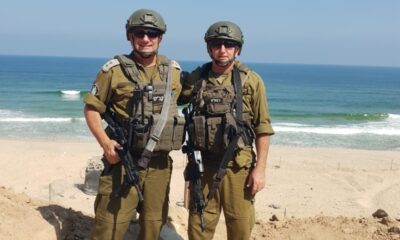
OpEds

Isolation of Israel another tactic of war
Hostile nations have surrounded Israel ever since 1948. Military scientists have coined a term to describe the condition in which nations or armies find themselves surrounded: operating from interior lines of communication. In spite of the serious psychological, physical, and logistical dangers of being encircled, obvious advantages emanate from those operating in these conditions.
Using the art manoeuvre, an agile opponent can assume a defensive position with one or several of the enemy’s attacking forces, thereby delaying their advance with a minimum of their troops deployed in a defensive posture.
Simultaneously, while this portion of the enemy is occupied with defending forces, an offensive can be launched on a single attacking force, applying overwhelming numerical and firepower. Therefore, operating on internal lines of communication allows for the swift switching from defensive to offensive and vice versa.
Manoeuvre warfare demands the utmost skill and daring, allowing enemy forces to be separated in time and space and dealt with individually, in a piecemeal fashion, at a time and place of the attacker’s choosing. The Israelis have mastered the art of manoeuvre warfare while operating from internal lines of communication, and with utmost flexibility and agility, defeated numerically superior opponents in 1956, 1967, and 1973.
Those assuming the posture of encircling, such as Israel’s neighbours, are said to operate from external lines of communication. Encirclement is advantageous if the attackers can advance their forces simultaneously and with equal vigour. Converging forces place the defenders on the horns of a dilemma.
The difficulty for those operating on external lines of communication is co-ordinating different national forces, often separated by many kilometres and possessing conflicting objectives.
Syria and Egypt came closest to defeating Israel with their simultaneous attack in 1973. Israel successfully – albeit with great difficulty and skill – switched forces from one theatre to another, assuming alternatively defensive and offensive postures to overcome the Syrian and then the Egyptian army. These specific laws of war are immutable, and apply equally to Israel’s situation today, just as they did in yesteryear.
At the operational level of war, modern-day Israel finds itself surrounded by hostile populations and militias in Gaza, the West Bank, and Lebanon. Delving deeper into the battlefield, Syria, Iran, and the Houthi militias in Yemen threaten to widen the war.
Should these somewhat disparate enemies acquire the ability and willingness to launch a co-ordinated attack from all fronts simultaneously, Israel would find itself in a precarious position.
Since 7 October, Israel has contained Hezbollah in the north by assuming a defensive position, while it concentrates its efforts on Hamas in Gaza. This is the classic position of one who operates from internal lines of communication.
Hamas, on the other hand, operating from external lines, has done its utmost to cajole the West Bank Palestinians as well as Hezbollah to join in attacking Israel with equal vigour. Therefore, Hamas will do its utmost to encourage a wider war.
Israel will seek to discourage that based on the historical geography and geopolitics governing the conduct of war in the region. Thus far, the Israelis have been successful in containing Hezbollah and dissuading West Bank Palestinians from joining the fray. Iran and Syria seem reluctant to strike Israel directly, and prefer to rely on their proxies. The sporadic attack on shipping by Houthis and the death of three United States servicemen in Jordan via drone attack threatens to widen the war should matters deteriorate.
It’s at the strategic level of war that Israel finds itself most under threat and least able to control the situation. Although Israel and South Africa both claimed victory in the recent International Court of Justice’s verdict, it’s Israel’s image that’s most vulnerable.
The regrettable South African initiative cannot be seen as an isolated enterprise but part of a more extensive worldwide process of delegitimising the very existence of Israel. This is Israel being surrounded and subjected to simultaneous co-ordinated attacks designed to weaken the resolve of allies as well as Israelis themselves through a process of progressive isolation.
The greatest threat to the powers seeking Israel’s political isolation would be the successful consummation of the Abraham Accords. Israel’s opponents are justified in claiming the first round, as the Abraham Accords have either been derailed or delayed indefinitely.
The Accords, coupled with the existing peace treaties with Egypt and Jordan, would have broken the ring of hostility surrounding Israel since its birth in 1948. The possible demise of lasting peace in the region is the ultimate tragedy of the current conflict.
So, what’s the endgame? A wider war must be avoided at all costs while eliminating Hamas as a political entity in Gaza. Israel faces the near-impossible task of ridding Gaza of Hamas with the minimum of collateral civilian casualties and the minimum of Israeli Defense Forces (IDF) casualties.
The IDF faces the unenviable challenge of maintaining its resolve in the face of a growing and vociferous enemy clamouring for an end to the conflict before Hamas is defeated.
Restraint is key, no matter how provocative Hezbollah becomes, thereby avoiding a multi-front war. As is her way of war and military tradition, she must confront one enemy at a time.
There’s a desperate need to reboot the Abraham Accords. A creative and bold initiative endorsed by the signatories of the Abraham Accords is urgently needed to provide a roadmap to take care of the political aspirations of the Palestinians. Israel needs to apply its manoeuvre doctrine at strategic level.
- Dr David Brock Katz is a research fellow at Stellenbosch University in the faculty of military science. He has published three books and numerous academic articles dealing with aspects of South African military history and military doctrine.










